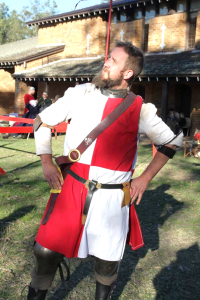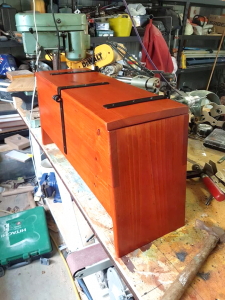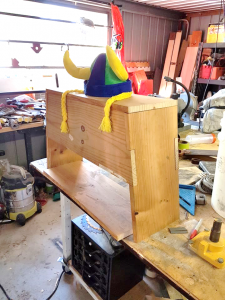Hi, I’m Johann, (or Lord Lord Jon Huslangr if you’re fancy) proprietor of the “Johann the Carpenter: an Unofficial SCA Newcomer’s blog” Facebook page. I was asked a few months back to share with you the philosophy/lifestyle-choice that is Speed Building and how you too, can apply it to your SCA adventures.
Figure 1: Johann, image courtesy of Baroness Ginevra Lucia di Namoraza
I’ve been in the SCA for just on a year now; residing in the Barony of Politarchopolis in Canberra (rich in Peers and red fabric). Mundanely, I’m a residential carpenter; specialising in “unique” constructions, meaning my life is spent solving problems with no two tasks the same, whoop whoop!
By now you might be thinking; “Aw man, he has a mad advantage to doing arts and sciences stuff. I’d never have those skills!” I’m here to tell you that mundane skills and how they transfer into the SCA stops around about the time you start researching how to ‘do things the period way’. Mundane skills and historic skills can be very different and, despite having an advantage in my craft, I still need a lot of motivation to translate my skills into SCA arts and sciences projects.
But enough of the intro, let’s talk Speedbuilding!
At my first event I was introduced to a concept of ‘Doers & Sayers’ – there are those that DO stuff and those that SAY they’re going to do stuff. Now, whether you’re of the former or feel embarrassed that you may fit better into the latter, the fact that you’re thinking about it at all is a big first step. Motivation is a key factor to a lot of activities and I, too, have seen both ends of the spectrum. In fact, nothing motivates me more than the rush of a deadline… and the ‘it’s only ever two weeks before Festival’ platitude.
Speed Building is a type of process best described by just getting in there and doing a thing in the quickest way possible; Sometimes many times over. It prioritises making a completed product quickly over making something historically accurate. For example, if I want to make a 6-plank chest reminiscent of the early Viking period, Speed Building would involve choosing the shortest path to achieving that goal.
At this point we’ve probably lost a few of our Laurels-readers but here’s the skinny; the more you practice, the better you get. I know, I sound like one of the Knight Instructors now but seriously: THE MORE YOU PRACTICE, THE BETTER YOU GET.
The Chest…first attempt
So, my first 6-plank chest was patterned using Pinterest (urgh, I know right?) with the dimensions governed by the timber I had lying around (rescued pinewood shelving pieces from a demolition job). Not exactly a textbook methodology of research or design but this is Speed Building so producing something is better than being overwhelmed by the hurdles of sourcing period-accurate materials on your first attempt.
So away I went: cutting, gluing, nailing, hammering, and painting. Before I knew it I had a chest, all medieval like; great for storing things, carrying things or just sitting on it (by far the most important design trait!) If I had gotten caught up in the detail of trying to perfectly recreate a Viking period chest, I may have been overwhelmed and never finished anything. But, by engaging my philosophy of the Speed Build I had a functional chest in no time.
Figure 2: Chest MkI image courtesy of Johann’s FB page
The Second building and Future works
Having won great fame and accolades for this venture into the arts and sciences…(*cough cough*) sorry, got distracted there for a moment, let’s try again… Thus, having finished my first project (Yay, happy dance!), I immediately began to feel the weight of “That’s not period, this isn’t period…etc.” self-doubt. This kind of self-doubt is a trap set to demotivate you by convincing you that your fun little project isn’t perfect. So now I want to tell you one of the greatest lessons I’ve learnt this past year:
“There is a difference between Finished and Perfect; while we all strive for the latter, there is nothing wrong with the former.”
And to me, that’s it. Speed Building isn’t about perfection; it’s about having a go. Having made my first chest, I then had the brain space to think about where I could do things better or “more period” next time. The second chest has better joints on the sides to direct the load-pathways and hold its shape, and I’m confident the third will be even better still.
Figure 3: Chest MkII image courtesy of Johann’s FB page
On a sidenote, having a recently finished project sitting beside you at an event is great bait for Laurels and other people (who may know a thing or two) to come over and have a chat about the item, help direct you to more information or discuss techniques you may not have previously thought of (Society-life-hacks for SCA-Noobs!)
So, go on, have a go, make all the things! Use whatever techniques you’re comfortable with whether they’re period or not. And if you’re so inspired, go again; increase the level of difficulty and aim for more historic! Maybe even keep a record like a projects diary, photographs, or blog so you can review and improve your skills and method of producing the item (it’s also great for arts and sciences competition documentation *sly wink*).
And, if you ever get stuck, there’s always a super enthusiastic Laurel lurking nearby that would be thrilled to discuss the project and direct you to someone else that’s doing similar stuff!
I’m Johann, thanks for reading, make all the things, oh and then I found 20 gold pieces!
Edited by Mistress Ceara Sionnach



